The Allure of Simple Loafers: A Comprehensive Exploration
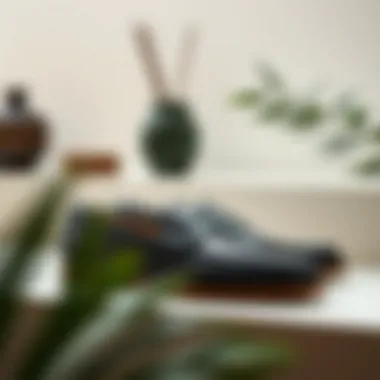
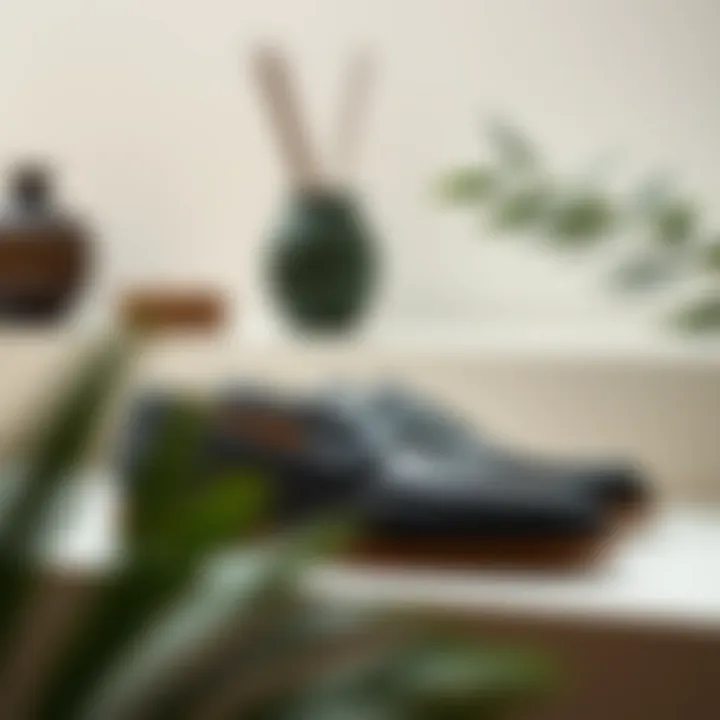
Intro
The simplicity of loafers is often where their allure lies. Amid a myriad of ever-changing fashion trends, these shoes maintain an essence of understated elegance that resonates with a wide audience. Rooted in tradition yet adaptable to contemporary styles, loafers have made quite a journey through the annals of fashion history. They are not merely shoes but rather a cultural artifact that suggests a casual sophistication. This article embarks on a detailed exploration of loafers, showcasing their significance, variations, and practical uses today.
In the upcoming sections, we’ll dissect the latest trends and investigate how loafers have evolved, retaining relevance in the modern fashion landscape. We will also delve into practical styling tips, empowering you to incorporate them seamlessly into your wardrobe. Understanding the craftsmanship and sustainable practices involved in loafer production is equally crucial; it informs better choices for style-savvy individuals. Therefore, whether you are a stylist, designer, or simply a fashion enthusiast, this guide will serve as an enriching resource to navigate the world of loafers, illustrating their timeless charm and practicality.
Intro to Simple Loafers
When talking about fashion footwear, few pieces embody versatility and elegance like simple loafers. They whisper sophistication without being loud or over-the-top. It’s not just about slipping them on; it’s how they blend seamlessly into different aspects of life, from casual outings to more formal affairs. Understanding simple loafers is essential for fashion enthusiasts, stylists, and marketers. This article unpacks the many layers—cultural significance, craftsmanship, and styling of these classic shoes.
Defining Simple Loafers
Simple loafers can be described in various ways, but at their core, they are slip-on shoes, characterized by a lack of laces, and can vary in terms of material and design. They're often made from leather or a synthetic alternative, giving them a polished yet relaxed appearance. The simplicity of their design accentuates the craftsmanship behind them, making them a staple across generations.
These loafers often come in a variety of styles including penny loafers, tassel loafers, and driving loafers. The beauty lies in their ability to be styled in numerous ways, allowing individuals to express personal styles without compromise. Highlighting the definition of simple loafers helps to frame the following sections in terms of significance and relevance in today’s fashion landscape.
The Significance of Simplicity in Design
Simplicity in design is not merely a matter of aesthetics; it embodies a philosophy of function and form. Simple loafers are the epitome of ‘less is more.’ Their streamlined look means they can fit into a myriad of wardrobes while still standing out. Simplicity signifies clarity—both in personal style and the design ethos behind the footwear.
The overarching theme here is that simple loafers help reduce the clutter in one’s wardrobe. When selecting shoes that blend formality and casualness, the simplicity speaks volumes. Keeping designs understated reduces decision fatigue. As the saying goes, “Keep it simple, stupid,” and in fashion, this mantra holds tightly to the truth that elegance does not require extravagance.
Simplicity is the ultimate sophistication. – Leonardo da Vinci
In a world where fast fashion often overwhelms personal style, embracing simple loafers means opting for timeless pieces that transcend trends. This fosters a shift in consumer mindset; one that appreciates the durability and versatility of thoughtfully designed footwear.
A Brief History of Loafers
Understanding the historical journey of loafers offers invaluable insights into their status today. Simple in appearance yet rich in narrative, loafers embody a slew of cultural shifts and aesthetic evolutions. By tracing their origins and significant milestones, one can appreciate the craftsmanship and intent that underlie this seemingly uncomplicated footwear. It’s also helpful to note how the different styles emerged to accommodate changing social norms and fashion trends. In short, this history provides context that deepens one’s appreciation for these shoes.
Origins and Evolution
The shoe we now classify as a loafer can trace its roots back to the 19th century. This era saw the rise of practical footwear for both men and women. The very first loafers were heavily influenced by traditional moccasins, which Indigenous peoples of North America originally fashioned. These early loafers were made primarily of leather, characterized by a slip-on design that allowed for ease and comfort.
Over the decades, the design evolved, largely influenced by European artisans. Norwegian fishermen wore a variation known as the Aurland shoe, named after the coastal villages where it originated. This style featured a sleek appearance and was constructed with superior leather, factors that would later resonate with other variations of loafers.
By the mid-20th century, loafers made their mark in American fashion, popularized by figures such as James Dean and later embraced by Ivy League students across the nation. The mid-century saw the creation of the Penny Loafer, which became an essential part of collegiate attire, primarily distinguished by a small slot on the upper where a penny could be inserted for good luck. This intersection of functionality and style laid the groundwork for loafers' presence in casual and formal wear alike.
Cultural Impact Across Decades
Loafers have not just been a footwear choice; they’ve carried cultural significance through multiple decades. In the 1960s and 70s, the counterculture movement adopted them as symbols of rebellion against traditional fashion norms. Artists, musicians, and activists alike gravitated toward loafers for their effortless style, signaling a shift toward comfort and nonchalance in everyday attire.
As the years rolled into the 1980s and 90s, loafers found themselves at the intersection of corporate America and high fashion. Power suits and loafers became staples for professionals, marking a shift in their representation—from casual footwear to symbols of authority and elegance. Prominent fashion houses began to introduce sophisticated designs, incorporating various materials like patent leather and suede to elevate their appeal.
"The loafer epitomizes versatility; it’s a canvas upon which cultural narratives are painted through changing styles and trends."
In the 21st century, loafers maintain their relevance, adapting to modern sensibilities while still referencing their rich history. Sustainability has become a pivotal focus, with brands exploring eco-friendly materials and production methods, thereby intertwining the timeless design with contemporary values.
Essential Features of Simple Loafers
When discussing the allure of simple loafers, it's crucial to delve into the features that make them stand out in the realm of footwear. The essential characteristics of simple loafers encapsulate not just their aesthetic appeal but also their functionality and comfort. Knowing these features can help consumers make informed decisions and appreciate the craftsmanship behind these shoes. Here, we investigate materials, craftsmanship, and design variations that contribute significantly to their unique charm.
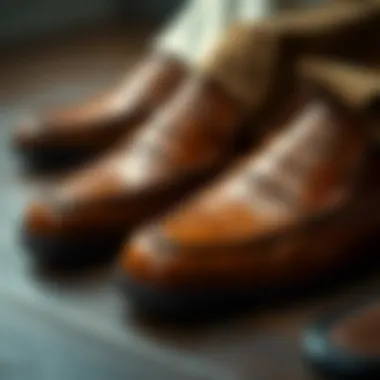
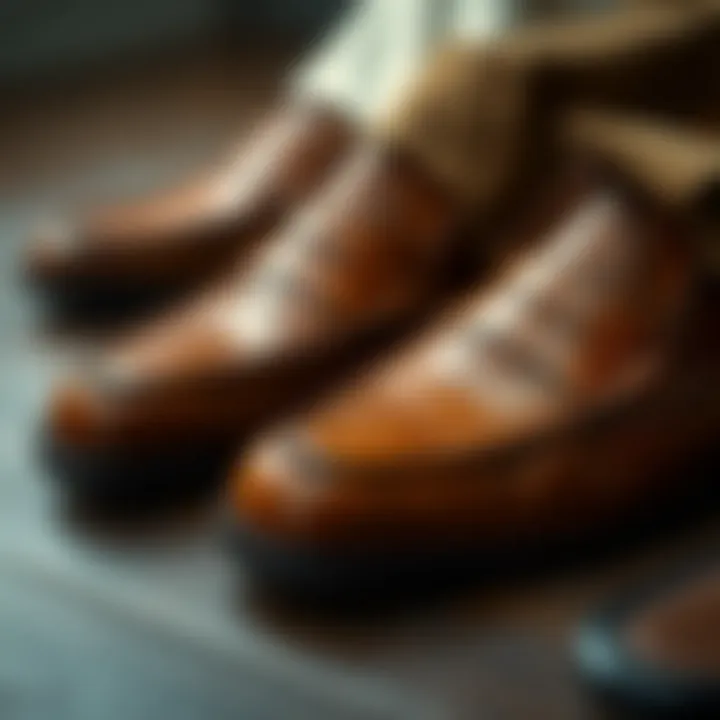
Materials and Craftsmanship
Materials and craftsmanship are the hallmarks of any footwear, and simple loafers are no exception. The choice of materials directly influences both the quality and longevity of the shoes.
Leather vs. Synthetic Materials
When it comes to loafers, leather holds a distinguished reputation. Leather is prized for its durability and natural breathability, making it an ideal choice for those who seek comfort in their footwear. It molds to the shape of the foot, providing a personalized fit over time. Furthermore, it boasts an inherent elegance that synthetic materials often struggle to match.
On the flip side, synthetic materials have gained traction for their affordability and ease of maintenance. They typically resist stains and are often more water-resistant than leather, providing practical benefits for everyday wear. However, they may lack the same level of adaptability as leather, and in the long run, their lifespan can be considerably shorter.
In essence, while leather loafers can be seen as an investment, synthetic varieties present a budget-conscious alternative for those just entering the world of loafers.
Handcrafted Excellence
One cannot dismiss the allure of handcrafted loafers. These shoes often reflect the profound skills of artisans who pour time and effort into their creation. Every stitch can be a testament to quality and attention to detail. What sets handcrafted loafers apart is their uniqueness — no two pairs are identical, which adds a distinct character to each set.
Handcrafted loafers tend to use premium materials, ensuring a level of craftsmanship that is tough to find in mass-produced shoes. However, the price point can sometimes be a hurdle for everyday consumers, as the intricacies of handcrafting often result in a significant cost.
Ultimately, while the allure of handcrafted loafers can be irresistible to many, their investment should be weighed against practicality and budget.
Manufacturing Techniques
The manufacturing process of loafers plays a pivotal role in their quality. Different techniques yield varying results, affecting everything from durability to comfort. Traditional methods, such as Goodyear welting, provide exceptional resilience by sewing the upper to the sole, allowing for resoling if necessary.
Conversely, contemporary manufacturing techniques, such as cement construction, offer faster production rates and lower costs. While this method is less durable, it can create a wider variety of styles available at more accessible prices.
This reflects a broader trend in the industry, where mass-produced options cater to demand but may sacrifice some quality for affordability. Still, a neatly executed manufacturing process can enhance the loafers' lifespan and save consumers money over time.
In summary, understanding manufacturing techniques enables consumers to select loafers that align with their values and lifestyle preferences.
Design Variations
The world of loafers is as diverse as the people who wear them. Design variations play a significant role in how these shoes fit into different lifestyles and fashion choices.
Traditional vs. Modern Styles
In the universe of loafers, traditional styles often invoke a sense of timelessness. These designs typically include classic shapes and decorative elements like tassels or penny slots. They can seamlessly transition from business settings to smart-casual outings.
On the other hand, modern styles adapt to contemporary trends, incorporating bolder shapes, unique materials, and experimental colors. This evolution allows wearers to express more of their personality through footwear, aligning with the current spirit of individualism in fashion. However, deploying modern design elements can sometimes render these shoes less versatile than their traditional counterparts.
To sum up, whether one opts for traditional or modern styles depends largely on personal preference and context.
Color Options and Patterns
The color palette for loafers is vast and varied. From jet black to vibrant reds, the options available allow for significant personal expression. A neutral pair can complement most outfits, while a bold hue can serve as a statement piece.
Patterns and textures further contribute to the uniqueness of loafers. Textured leathers or unique prints can elevate a simple design, giving it a distinct flair. Yet, with bold choices comes a challenge — finding the right balance in styling can be tricky. A strong pattern might clash with other elements of an outfit, requiring careful consideration.
When choosing colors and patterns, wearers should consider versatility versus individuality, ensuring their loafers align with their overall wardrobe.
Functional Elements


Functionality cannot be underestimated in the realm of loafers. Features such as arch support, cushioned footbeds, and slip-resistant soles can determine comfort levels significantly. For example, loafers designed with supportive insoles cater specifically to those who will be on their feet for extended periods.
Moreover, many loafers incorporate flexible materials that allow for natural ease of movement, which enhances the overall wearing experience. However, these functional elements may sometimes come with compromises in appearance or style, particularly if they aim for a more sporty look.
Styling Simple Loafers
Styling simple loafers blends the art of fashion and comfort, showcasing the adaptability of this footwear in various settings. This section aims to reflect on how loafers can seamlessly integrate into different attire. It becomes apparent that understanding how to best style these shoes can elevate one’s fashion game while ensuring ease and comfort.
Pairing with Casual Attire
Casual attire offers a canvas where loafers can express their versatility. Pairing loafers with jeans and a tucked-in shirt delivers a crisp look without trying too hard. The low-profile nature of loafers adds subtle elegance, while jeans provide a laid-back vibe. One might think of a dark wash jean with a light cotton shirt—this combination gives off an effortless appeal. It’s not just about looking presentable; it’s also about feeling at ease when out and about.
As these shoes have a rich variety of colors and textures, they can flawlessly complement a sweatshirt or a classic tee as well, enhancing an informal outfit's overall aesthetic. Comfort is key here, the right loafers won't pinch or rub, letting one enjoy a day out without distraction.
Elevating Formal Wear
When transitioning from casual to formal, loafers possess an inherent sophistication. Wearing them with tailored trousers can exude professionalism without sacrificing personal style. Imagine a pair of polished black loafers accompanying dark gray slacks—a combination that shouts refinement. The sleek design of loafers allows individuals to maintain a sharp profile, making them ideal for business meetings or formal events.
However, one must choose wisely. The material and finish of the loafers can determine if they fit the formality required. Patent leather loafers can indeed be a brilliant fit for a more upscale event, whereas suede loafers might work for smarter-casual occasions. Therefore, understanding the specific demands of the event is crucial.
Seasonal Styling Tips
Styling loafers with an eye on the seasons ensures that they remain a staple throughout the year. Each season presents unique opportunities to innovate and adapt one’s wardrobe.
Spring and Summer Outfit Ideas
Spring and summer outfits often emphasize light colors and breathable fabrics. Loafers made of canvas or lightweight leather can be ideal for this time of year. Pairing loafers with chinos or cotton shorts can give a relaxed yet chic look, suitable for brunch or stylish outings in the park.
Bright hues or pastel shades in loafers can reflect the warmth of the season, bringing a playful yet sophisticated edge to the outfit. One unique feature about loafers in these seasons is their breathability—perfect for those warmer months when comfort overtakes the need for bulk.
Many appreciate that lightweight loafers don’t cause sweating, enabling one to enjoy longer days without discomfort. However, individuals must consider the specific styles chosen, as overly flashy designs might not lend themselves to every occasion, sometimes opting for simplicity is the win.
Autumn and Winter Combinations
Autumn and winter require a more robust consideration, especially as weather shifts demand warmer attire. Loafers can be effectively paired with tailored coats or chunky knit sweaters. For instance, combining dark loafers with dark jeans and a long, tailored overcoat not only protects from the chill but maintains an air of sophistication.
The unique feature of loafers during the colder months is their adaptability. Suede loafers can fit stylishly into this equation, adding texture to an otherwise stark wardrobe. One significant advantage of loafers in this setting is their ability to maintain a polished look without the fuss of laces that can freeze or muddy.
Yet, durability is key in these seasons. Choosing loafers that withstand the elements becomes a priority. All in all, combining loafers with stylish outerwear encapsulates the essence of fall and winter while keeping the essentials of comfort and style front and center.
"Simplicity is the ultimate sophistication." – Leonardo da Vinci
The Role of Simple Loafers in Sustainability
Simple loafers exemplify the balance between style and conscious living, making them a focal point in discussions of sustainability in fashion. As consumers grow increasingly aware of the environmental impact of their purchases, footwear—particularly loafers—has found itself scrutinized under the lens of eco-friendliness. This section will explore the implications of production methods, the significance of choosing sustainable brands, and how these factors contribute to a growing movement towards environmentally responsible choices in our wardrobes.
Environmental Implications of Production
When it comes to footwear, the journey from raw materials to finished product is often riddled with environmental costs. The production of simple loafers typically involves various processes, each with its potential ecological implications. For instance, traditional leather tanning can be a resource-intensive practice, often using harmful chemicals that pose risks to both the environment and workers' health.
However, it doesn’t end here. The sourcing of materials also plays a crucial role. Synthetic options, while cheaper and often more durable, rely heavily on petrochemicals, contributing to pollution and climate change. As such, consumers are increasingly prompted to evaluate not only the aesthetics of loafers but the hidden costs associated with their production.
"Purchasing choices impact more than just personal style; they ripple through communities and ecosystems alike."
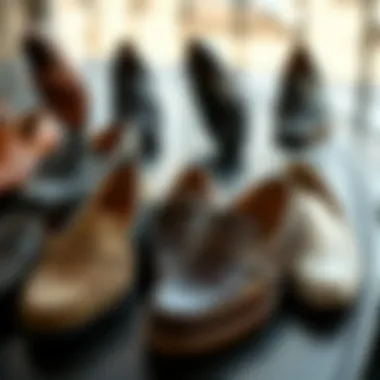

To further the cause of sustainability, brands have begun to innovate. Eco-friendly loafers made with vegetable-tanned leather or recycled materials are hitting the market, allowing fashion lovers to stride confidently while supporting responsible practices. By understanding the lifecycle of a product, consumers can align their buying choices with their values, leading to more sustainable fashion industry practices overall.
Choosing Sustainable Brands
Selecting sustainable brands is essential for consumers seeking to make a positive impact. Not all loafers are created equal, and research is paramount in finding brands committed to sustainability. Look for brands that advertise transparent sourcing and manufacturing processes. Many companies now place ethos at the forefront, showcasing the origins of their materials and the ethics behind their labor practices.
When evaluating brands:
- Check certifications: Look for eco-labels like Global Organic Textile Standard (GOTS) or the Leather Working Group (LWG) that ensure environmentally friendly production.
- Research company missions: Brands that emphasize sustainability often have a mission statement highlighting their environmental goals.
- Emphasize longevity and repair options: Brands that promote durability and offer repair services signal a commitment to reducing waste.
Some noteworthy brands making strides in sustainability within the loafer segment include Allbirds and Rothy's, which focus on minimizing waste and using renewable materials. By supporting such businesses, consumers can be part of a necessary shift towards more sustainable fashion practices, proving that choices matter.
In summary, the role of simple loafers in sustainability is pivotal, as these footwear pieces embody a blend of style and ethical production practices. Recognizing the environmental implications of their production and choosing sustainable brands can lead to a more conscious and responsible approach to personal style.
Consumer Considerations
Understanding consumer considerations is vital when it comes to selecting simple loafers. This section delves into specific elements that influence buying decisions, focusing on fit, comfort, and value—factors that can ultimately elevate or mar the experience of wearing these stylish shoes.
Evaluating Fit and Comfort
The fit of a loafer isn't merely about size; it's about how it aligns with the shape of your foot. When shopping for loafers, one should keep in mind that different brands may have slight variances in sizing, making it essential to try them on whenever possible. A great pair of loafers should hug your foot just right—neither too loose nor too tight to prevent blisters or discomfort.
Additionally, consider the design. For example, some loafers feature cushioned footbeds designed for optimal comfort. Materials play a crucial role here as well; genuine leather often molds to the wearer’s foot over time, providing a personalized fit and genuine feel. Opt for options with adequate arch support if you plan to wear them for long stretches.
"Fit is not just a number; it’s a feel. Your loafers should feel like a second skin, transferring your steps lightly, not dragging you into a mire of discomfort.”
Pricing and Value Assessment
When it comes to pricing, consumers are faced with a broad spectrum. You might find loafers that are wallet-friendly yet stylish, while others come with a hefty price tag that claims premium features. But how do you define value in this case?
- Quality over Quantity: Investing in a pair of high-quality loafers can save you money in the long run. Cheaper options may wear down quicker, leading to repeated purchases.
- Brand Reputation: Some brands carry a legacy of craftsmanship and sustainability practices that are worth the extra pennies. A well-regarded label may offer not just style but assurance of quality.
- Longevity and Versatility: Assess how well a loafer fits into your wardrobe. If it pairs flawlessly with multiple outfits, it justifies a higher price point.
Ultimately, being a savvy shopper means balancing your budget against potential long-term value and satisfaction. Determine what features matter most to you, consider how often and in which scenarios you plan to wear them. This holistic reflection can guide you toward making a purchase that your future self will thank you for.
The End: The Enduring Appeal of Simple Loafers
As we bring our exploration of simple loafers to a close, one can’t help but appreciate why these humble shoes have not only endured through the ages but have also maintained a strong foothold in fashion. The cultural significance and design aesthetics of loafers are deeply rooted in their practicality and versatility. From boardrooms to casual outings, these shoes complement various looks while saving one from the nuisance of laces.
Reflection on Timelessness
When we ponder on the essence of timeless style, simple loafers epitomize it. Their clean lines and minimalist design make them a perfect canvas for any fashion statement. Unlike trends that come and go, loafers possess a distinct charisma that transcends seasons.
Additionally, their ability to be dressed up or down is central to their timeless appeal. For instance, pairing a sleek pair of black leather loafers with a tailored suit can convey authority and professionalism, while wearing a more relaxed suede variant with rolled-up chinos gives off a laid-back vibe. It's this dual nature that solidifies their place as a staple footwear choice.
"Simplicity can be complex, yet loafers remind us that often, less is more."
In a world saturated with fleeting styles, the loyalty to simple loafers speaks volumes. Their adaptability is a key factor that caters to both conservative tastes and contemporary trends, allowing individuals to express personal style without getting too tangled up in fashion do's and don’ts.
Looking Ahead: Future Trends
As we gaze towards the horizon, it’s worth considering how simple loafers may continue to evolve. With an increasing shift towards sustainable fashion, many brands are adopting eco-friendly materials without compromising on the classic look. Expect to see more options created with recycled elements or ethically sourced materials, appealing to environmentally conscious consumers who value both aesthetics and ethics.
Moreover, technological advancements in footwear production might bring forward smarter designs. Imagine loafers that integrate cushioning technology to enhance comfort. Furthermore, the likely emergence of customized shoes may lead to innovative designs that cater to a customer’s unique style preferences.
In terms of color palettes, we might witness an expansion beyond conventional shades; expect to see bold hues and striking patterns to capture the attention of the daring fashionista. As brands push boundaries, loafers could stand at the intersection of classic charm and modern innovation, ingraining them deeper into the fabric of future fashion trends.
In summary, the enduring allure of simple loafers isn’t merely about a shoe; it’s a harmonious blend of tradition, adaptability, and an eye towards an evolving future in fashion. Embracing loafer styles now sets the stage for being at the forefront of understated elegance.















